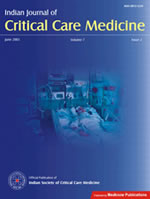
|
Indian Journal of Critical Care Medicine
Medknow Publications on behalf of the Indian Society of Critical Care Medicine
ISSN: 0972-5229 EISSN: 1998-359x
Vol. 7, Num. 4, 2003, pp. 285-286
|
Indian Journal of Critical Care Medicine, Vol. 7, No. 4, , 2003, pp. 285-286
Guidelines
Guidelines for aute medical management of severe traumatic brain injury in infants and children
Khilnani P
Department of Paediatrics, Indraprastha Apollo Hospital,
Sarita Vihar, New Delhi - 110044
Correspondence Address:B-42, Panchsheel Enclave, New Delhi - 110017
praveenk@nde.vsnl.net.in
Code Number: cm03008
The guidelines for the acute medical management of severe traumatic brain injury in infants, children, and adolescents were published on June 6 2003 as special supplements to Pediatric critical care medicine, Critical Care Medicine and the Journal of Trauma, ensuring a multidisciplinary audience of more than 30,000 speciality physicians. According to brain injury association of America, more than 1 million children in the US sustain brain injuries each year, of whom 250000 are admitted to hospitals, 7000 die, and 30,000 are permanently disabled. Indian statistics though not available should be comparable at the least. Following is a summary of available evidence in the literature.this information could be used to apply to care of head injures infants and children in the Indian scenario.
Evidence highlights
- Pediatric patients with traumatic brain injury should be treated
in a pediatric trauma center or, failing that,a tertiary care hospital
with pediatric trauma care capability.
- Hypoxia must be treated appropriately; however, there is no evidence
to support endotracheal intubation versus bag-mask ventilation during
transfer to the hospital.
- Prophylactic treatment with mannitol or mild hyperventilation is
usually unnecessary but should be used in patients with evidence of
cerebral herniation or worsening neurological function.
- Intracranial pressure monitoring is indicated for children with a
Glasgow coma score of less than 8,but it may also be employed for children
in whom serial neurological examination is not feasible.
- Treatment for increased intracranial pressure should be initiated
when the pressure rises more than 20-25 mm Hg
- The sensitivity of ventricular catheters, external guage transducers,
or catheter tip pressure transducers in monitoring intracranial pressure
appears equal. Subarachnoid, subdural, epidural and externally placed
monitors are less accurate.
- Cerebral perfusion pressure should be maintained at more than 40
mm Hg. Further research is needed to determine an optimal cerebral
perfusion pressure range.
- The routine use of sedation and neuromuscular blockade in severe
pediatric traumatic brain injury is not supported by scientific evidence.
Coughing and bucking on the tube and suctioning maneuvers leading
to increased intracranial pressure may necessitate their use, in
practice.
- Cerebrospinal fluid drainage via ventriculostomy is a first line
option for refractory elevated intracranial pressure; lumbar drainage
may be added in patients with open cisterns on imaging and without
major mass lesions or midline shift.
- Mannitol or hypertonic saline are both acceptable agents for lowering
intracranial pressure.
- Hyperventilation should only be used as a second line method to reduce
refractory intracranial pressure. In this setting, the paCO2 should
be kept at 25-30 mmhg.
- High dose barbiturates may also be employed in the treatment of
refractory increased intracranial pressure. Patients receiving this
therapy require extremely close monitoring for hypotension
- Hyperthermia has been postulated to increase secondary mechanisms
of brain injury in adults. Therefore, hyperthermia should be avoided
in younger patients. Hypothermia on the other hand, may be beneficial,
and when intracranial hypertension is refractory, the authors recommend
that it be considered, despite lack of evidence.
- Decompression craniectomy may also be considered to improve refractory
intracranial hypertension. Surgical interventions may be more successful
in patients with reversible brain insults.
- There is no evidence to recommend steroid therapy in children with
traumatic brain injury.
- Although research had not directly addressed outcomes in pediatric
patients with traumatic brain injury, nutritional support should be strongly
considered with a goal of 130%-160%of resting metabolic
expenditure.
- Prophylactic antiepileptic medications are not recommended.
Conclusion
- Prompt recognition and transfer of pediatric victims of traumatic
brain injury is paramount to good outcomes
- Intracranial pressure should be monitored and treated if >20 mm
hg in children with severe brain injury
- Mannitol, hypertonic saline, ventricular drainage, hyperventilation, barbiturates and hypothermia should be considered in refractory intracranial hypertension
- Steroids and prophylactic antiepileptics have no role in traumatic brain injury in children.
References
| 1. | Guidelines for the acute medical management of severe traumatic brain injury in infants,children, and adolescents: Pediatr Crit Care Med 2003;4:3:S1-72. Back to cited text no. 1 |
Copyright 2003 - Indian Journal of Critical Care Medicine Free full text also available from:
http://www.ijccm.org/article.asp?issn=0972-5229;year=2003;volume=7;issue=4;spage=285;epage=286;aulast=Khilnani
|
